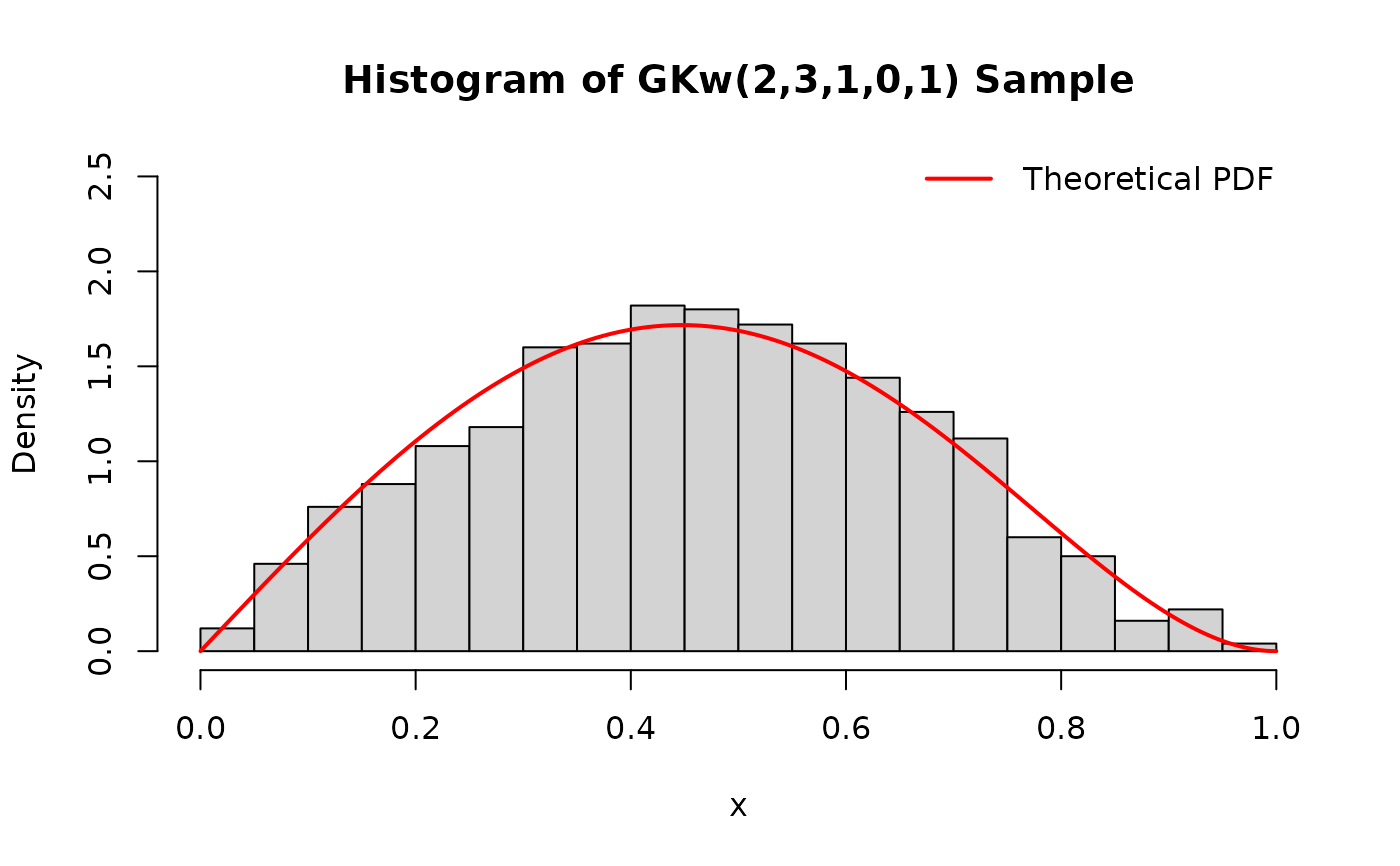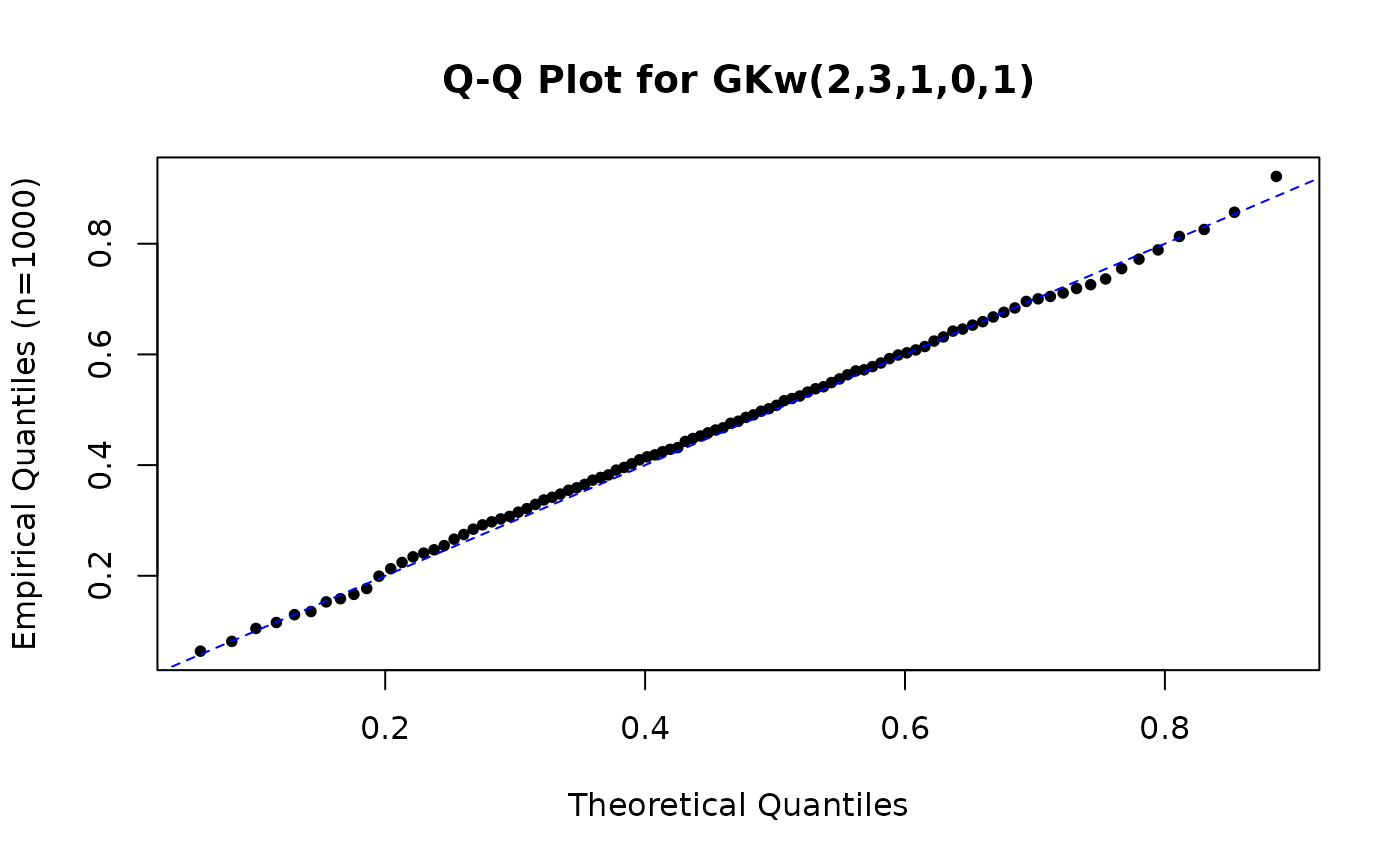Generates random deviates from the five-parameter Generalized Kumaraswamy (GKw) distribution defined on the interval (0, 1).
Arguments
- n
Number of observations. If
length(n) > 1, the length is taken to be the number required. Must be a non-negative integer.- alpha
Shape parameter
alpha> 0. Can be a scalar or a vector. Default: 1.0.- beta
Shape parameter
beta> 0. Can be a scalar or a vector. Default: 1.0.- gamma
Shape parameter
gamma> 0. Can be a scalar or a vector. Default: 1.0.- delta
Shape parameter
delta>= 0. Can be a scalar or a vector. Default: 0.0.- lambda
Shape parameter
lambda> 0. Can be a scalar or a vector. Default: 1.0.
Value
A vector of length n containing random deviates from the GKw
distribution. The length of the result is determined by n and the
recycling rule applied to the parameters (alpha, beta,
gamma, delta, lambda). Returns NaN if parameters
are invalid (e.g., alpha <= 0, beta <= 0, gamma <= 0,
delta < 0, lambda <= 0).
Details
The generation method relies on the transformation property: if
\(V \sim \mathrm{Beta}(\gamma, \delta+1)\), then the random variable X
defined as
$$
X = \left\{ 1 - \left[ 1 - V^{1/\lambda} \right]^{1/\beta} \right\}^{1/\alpha}
$$
follows the GKw(\(\alpha, \beta, \gamma, \delta, \lambda\)) distribution.
The algorithm proceeds as follows:
Generate
Vfromstats::rbeta(n, shape1 = gamma, shape2 = delta + 1).Calculate \(v = V^{1/\lambda}\).
Calculate \(w = (1 - v)^{1/\beta}\).
Calculate \(x = (1 - w)^{1/\alpha}\).
Parameters (alpha, beta, gamma, delta, lambda)
are recycled to match the length required by n. Numerical stability is
maintained by handling potential edge cases during the transformations.
References
Cordeiro, G. M., & de Castro, M. (2011). A new family of generalized distributions. Journal of Statistical Computation and Simulation
Kumaraswamy, P. (1980). A generalized probability density function for double-bounded random processes. Journal of Hydrology, 46(1-2), 79-88.
Examples
# \donttest{
set.seed(1234) # for reproducibility
# Generate 1000 random values from a specific GKw distribution (Kw case)
x_sample <- rgkw(1000, alpha = 2, beta = 3, gamma = 1, delta = 0, lambda = 1)
summary(x_sample)
#> Min. 1st Qu. Median Mean 3rd Qu. Max.
#> 0.01524 0.31493 0.46345 0.46265 0.60804 0.96441
# Histogram of generated values compared to theoretical density
hist(x_sample, breaks = 30, freq = FALSE, # freq=FALSE for density scale
main = "Histogram of GKw(2,3,1,0,1) Sample", xlab = "x", ylim = c(0, 2.5))
curve(dgkw(x, alpha = 2, beta = 3, gamma = 1, delta = 0, lambda = 1),
add = TRUE, col = "red", lwd = 2, n = 201)
legend("topright", legend = "Theoretical PDF", col = "red", lwd = 2, bty = "n")
 # Comparing empirical and theoretical quantiles (Q-Q plot)
prob_points <- seq(0.01, 0.99, by = 0.01)
theo_quantiles <- qgkw(prob_points, alpha = 2, beta = 3, gamma = 1, delta = 0, lambda = 1)
emp_quantiles <- quantile(x_sample, prob_points)
plot(theo_quantiles, emp_quantiles, pch = 16, cex = 0.8,
main = "Q-Q Plot for GKw(2,3,1,0,1)",
xlab = "Theoretical Quantiles", ylab = "Empirical Quantiles (n=1000)")
abline(a = 0, b = 1, col = "blue", lty = 2)
# Comparing empirical and theoretical quantiles (Q-Q plot)
prob_points <- seq(0.01, 0.99, by = 0.01)
theo_quantiles <- qgkw(prob_points, alpha = 2, beta = 3, gamma = 1, delta = 0, lambda = 1)
emp_quantiles <- quantile(x_sample, prob_points)
plot(theo_quantiles, emp_quantiles, pch = 16, cex = 0.8,
main = "Q-Q Plot for GKw(2,3,1,0,1)",
xlab = "Theoretical Quantiles", ylab = "Empirical Quantiles (n=1000)")
abline(a = 0, b = 1, col = "blue", lty = 2)
 # Using vectorized parameters: generate 1 value for each alpha
alphas_vec <- c(0.5, 1.0, 2.0)
n_param <- length(alphas_vec)
samples_vec <- rgkw(n_param, alpha = alphas_vec, beta = 2, gamma = 1, delta = 0, lambda = 1)
print(samples_vec) # One sample for each alpha value
#> [1] 0.4386491 0.2135709 0.8667377
# Result length matches n=3, parameters alpha recycled accordingly
# Example with invalid parameters (should produce NaN)
invalid_sample <- rgkw(1, alpha = -1, beta = 2, gamma = 1, delta = 0, lambda = 1)
#> Warning: rgkw: invalid parameters at index 1 (alpha,beta,gamma>0, delta>=0, lambda>0)
print(invalid_sample)
#> [1] NA
# }
# Using vectorized parameters: generate 1 value for each alpha
alphas_vec <- c(0.5, 1.0, 2.0)
n_param <- length(alphas_vec)
samples_vec <- rgkw(n_param, alpha = alphas_vec, beta = 2, gamma = 1, delta = 0, lambda = 1)
print(samples_vec) # One sample for each alpha value
#> [1] 0.4386491 0.2135709 0.8667377
# Result length matches n=3, parameters alpha recycled accordingly
# Example with invalid parameters (should produce NaN)
invalid_sample <- rgkw(1, alpha = -1, beta = 2, gamma = 1, delta = 0, lambda = 1)
#> Warning: rgkw: invalid parameters at index 1 (alpha,beta,gamma>0, delta>=0, lambda>0)
print(invalid_sample)
#> [1] NA
# }